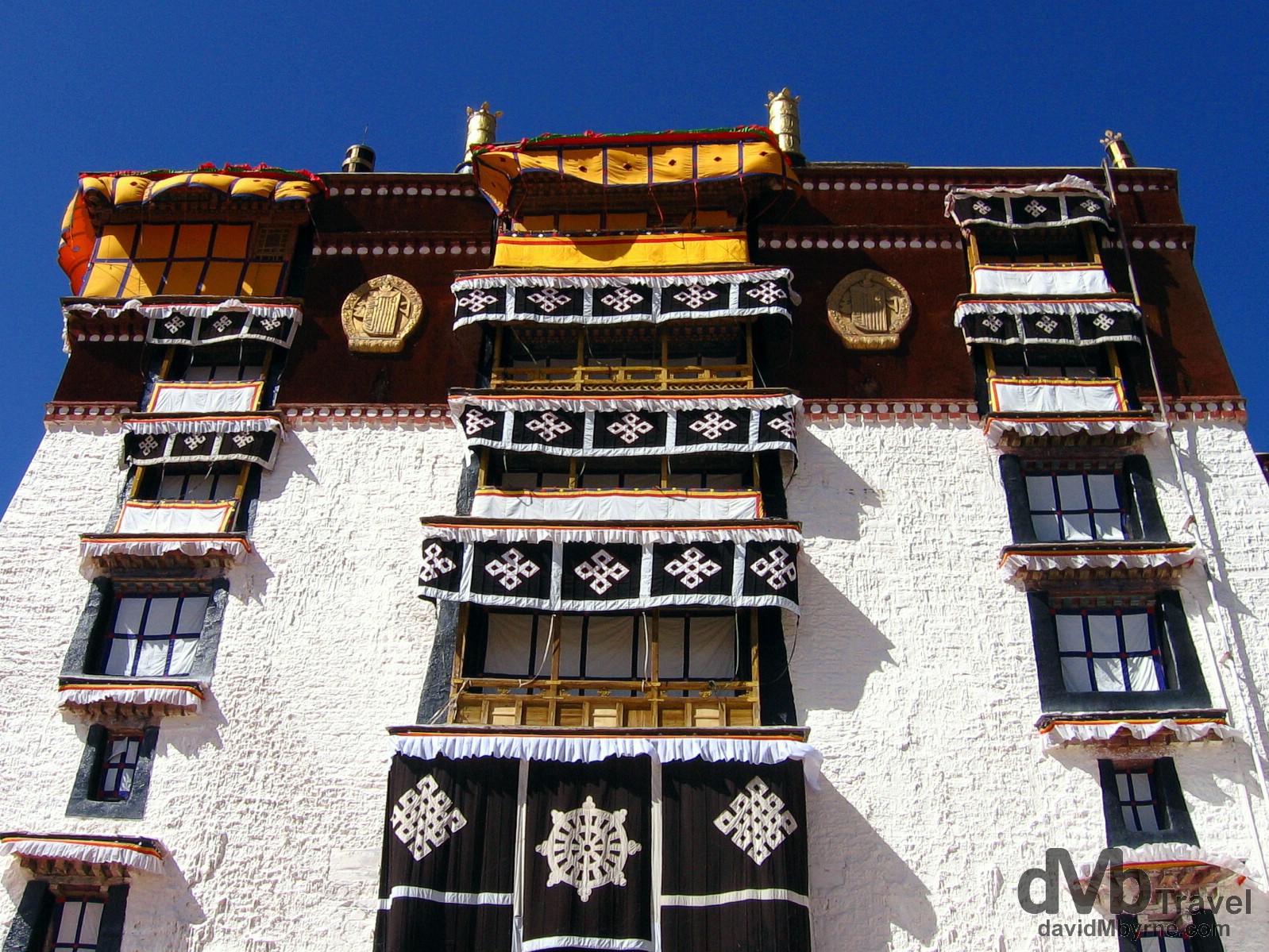The Roof of the World. We’re seeing that slogan a lot since we got here to Lhasa, Tibet, off the Qinghai–Tibet Railway. That was Sunday evening. It’s now Tuesday morning and yesterday was our first full day of acclimatising and taking in the sights and smells of what is a truly different kind of city. Located high on the Tibetan Plateau & surrounded by the snow-capped Himalayas, there is an intoxicating lure to Lhasa that few other places on earth can match. Maybe it’s the sheer isolation. Maybe it’s the fact that it was closed off to the west for most of its existence. Maybe it’s the religious monuments that turned the whole region into the Buddhist kingdom it is today, a kingdom that so intoxicated early western travellers, the mythical Shangri-la locked away in its Himalayan mountain fortress.
______________________________________________________________________
Pilgrims || February 26th, 2008
______________________________________________________________________
Lhasa seems to have the same overcrowding and pollution that most Chinese cities suffer from but there’s a certain magic to this place that’s missing in China proper. We reckon it’s because of all the holy stuff going on around us; there are Buddhist pilgrims everywhere, all doing what they have to do to in an effort to reach enlightenment. It’s what this place is all about.
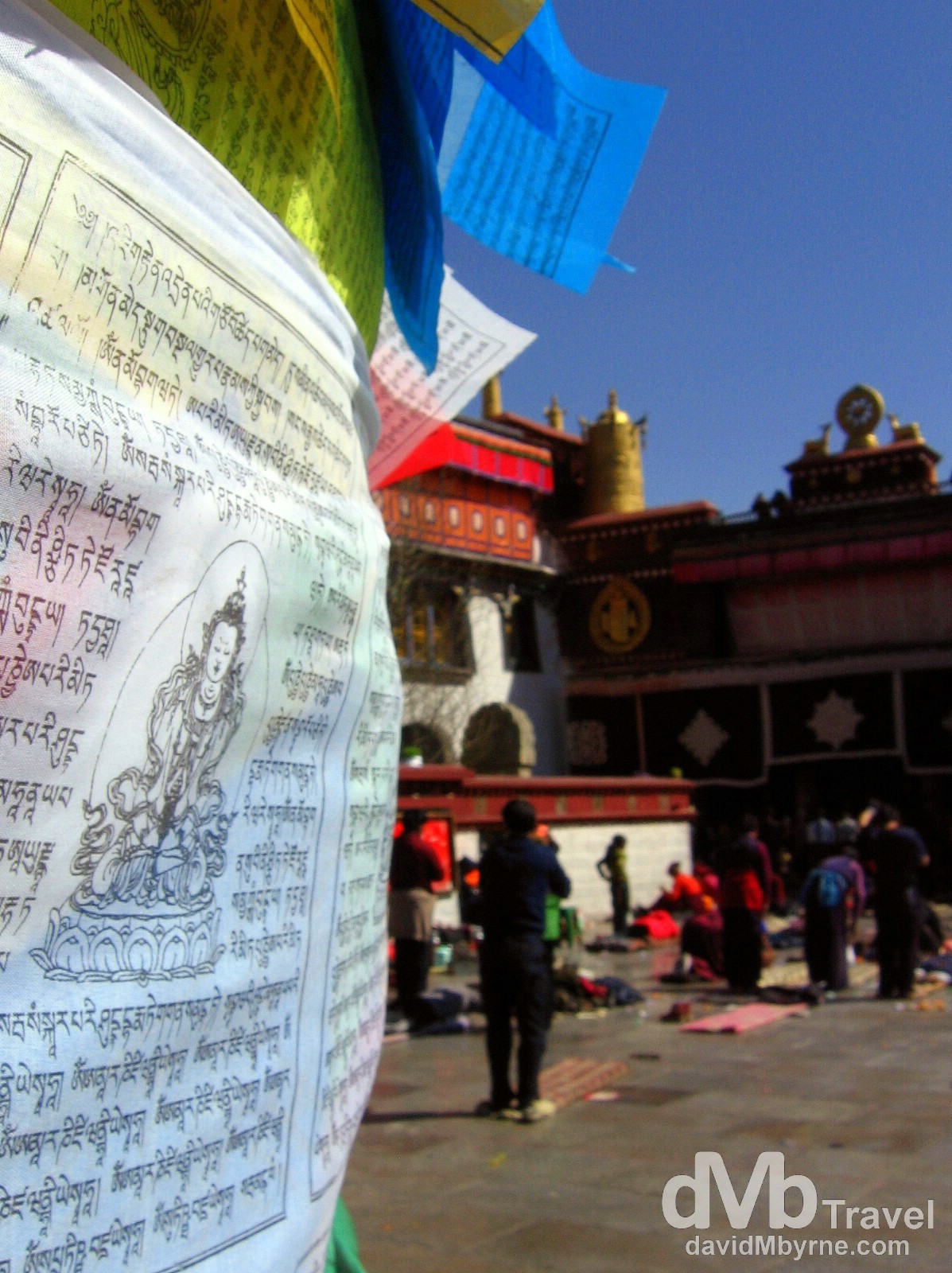
Prayer flags adorn a post in Barkhor Square fronting the Jokhang Temple in Lhasa, the holiest temple in the Tibetan Buddhist world and along with the Potala Palace (see later pictures) one of the two central city, UNESCO World Heritage listed sites. Lhasa is an object of devout pilgrimage for Tibetan Buddhists and the Jokhang is abuzz at all hours of the day with crowds of pilgrims prostrating themselves in front of the temple doors. It’s a unique sight to behold. Barkhor Square, Lhasa, Tibet. February 25th, 2008.
Seen as we’re not Buddhists we’d rather spend our time walking around looking at all the pilgrims doing their thing (while they look right back at us). And so that’s what we’ve been doing since we got here, commenting every so often as to how far removed from home we feel here in Tibet.
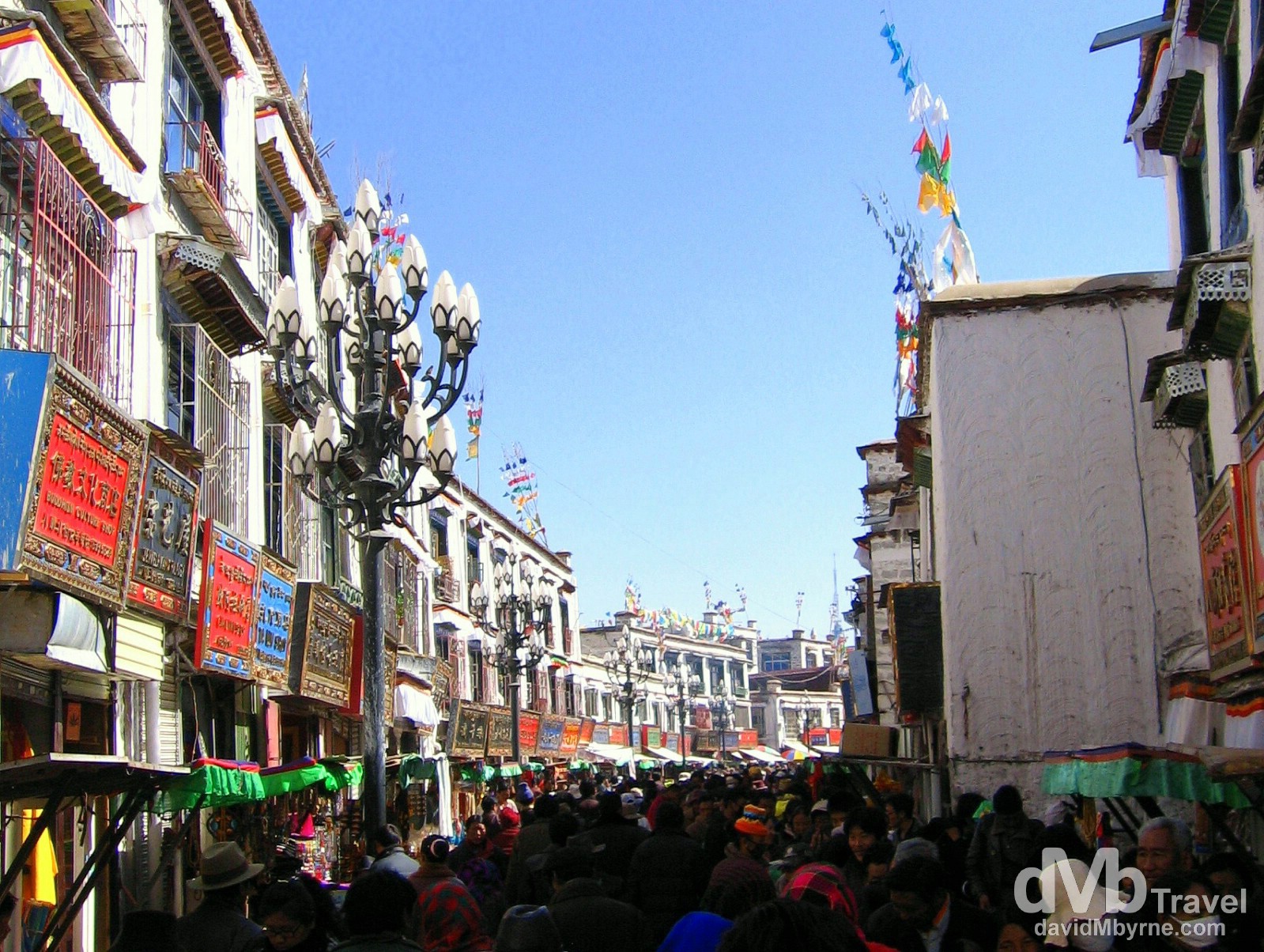
Pilgrim crowds walking the Barkhor Circuit in Lhasa. Dressed in traditional clothing while chanting prayers, spinning their prayer wheels & burning incense, the pilgrims walk in a clockwise direction around the outside of the Jokhang Temple following a circuit, the so-called Barkhor circuit, through the jumbled, stall-lined alleyways of the Barkhor area of eastern Lhasa (western Lhasa is a modern Chinese city and is of little interest to tourists). It really is quite the sight. Barkhor, Lhasa, Tibet. February 25th, 2008.
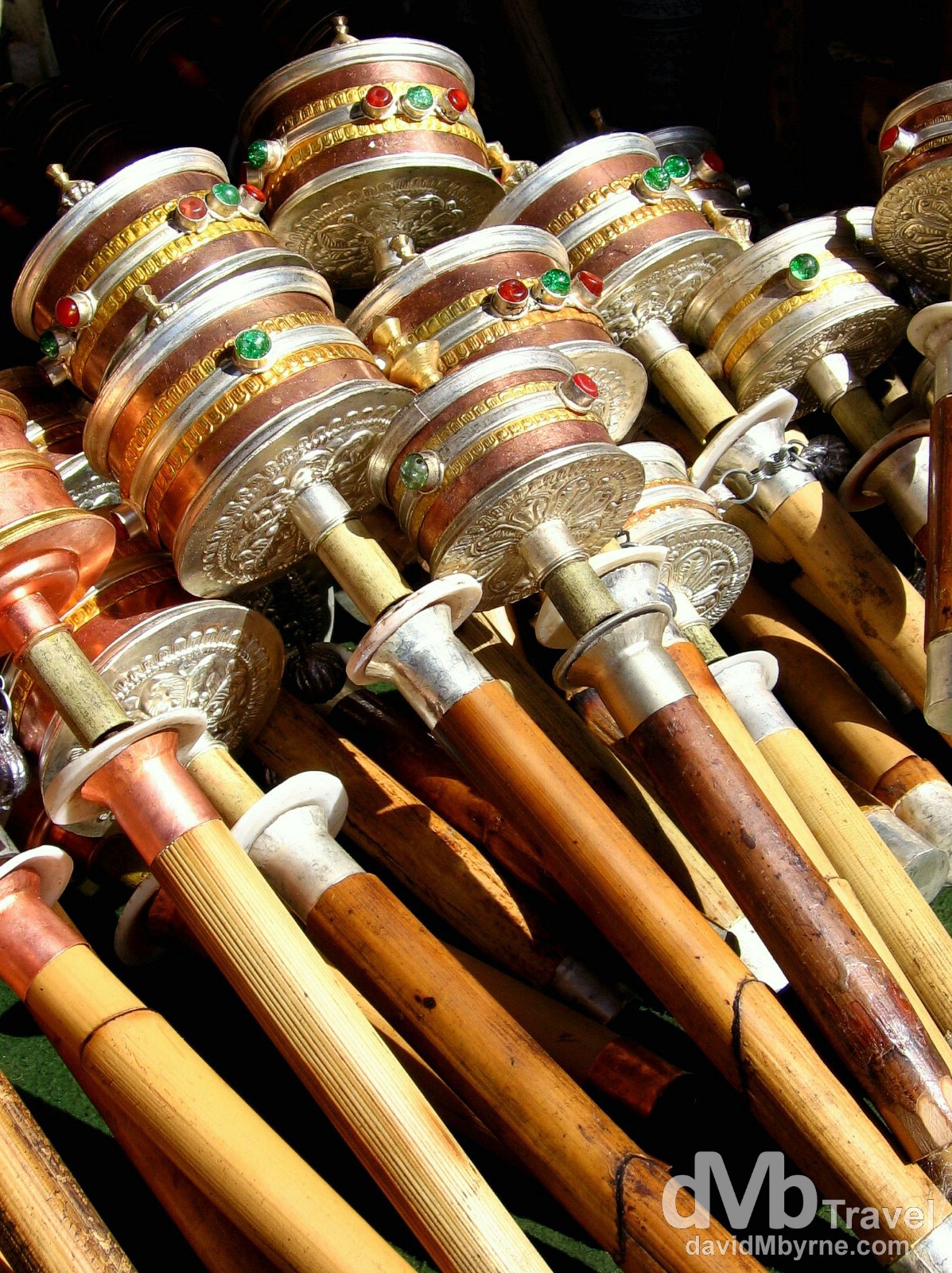
Buddhist prayer wheels on sale among other Buddhist pilgrim paraphernalia (prayer flags, Lama pictures, scarves, incense etc.) at a stall on the Barkhor Circuit. The stalls lining the Barkhor pilgrim circuit also sell all manner of non-religions goods. I saw saddles & stirrups, Chinese army gear, jewellery, blankets, cassette tapes, carpets, & tin trunks, to name but a few random items on sale. Barkhor, Lhasa, Tibet. February 25th, 2008.
Due mainly to its isolation, Lhasa has always stirred the imagination of those in the west, who didn’t know much about the city until the British arrived here in 1904. This is what one member of an early British party had to say of Lhasa.
While I wouldn’t go so far as to call Lhasa an ‘unsanitary slum’, it’s fair to say it does have some sanitary issues. We may not (yet) have seen ‘piles of refuse’ or any creatures ‘competing for nameless delicacies in open sewers’ but we have seen a grown human, a beggar mind you, defecate on the side of the main street in full view of passing traffic. That little eye-opener was part of an interesting day, a day in which we had an introductory look at the city’s two aforementioned blue-ribboned, UNESCO-listed sights – the Jokhang Temple and the Potala Palace. We also noted, with some surprise I might add, how hot it is here and how we’d better be careful with high-altitude UV rays – at Lhasa’s 3,650-metre (12,000 ft) altitude they shouldn’t be taken lightly.
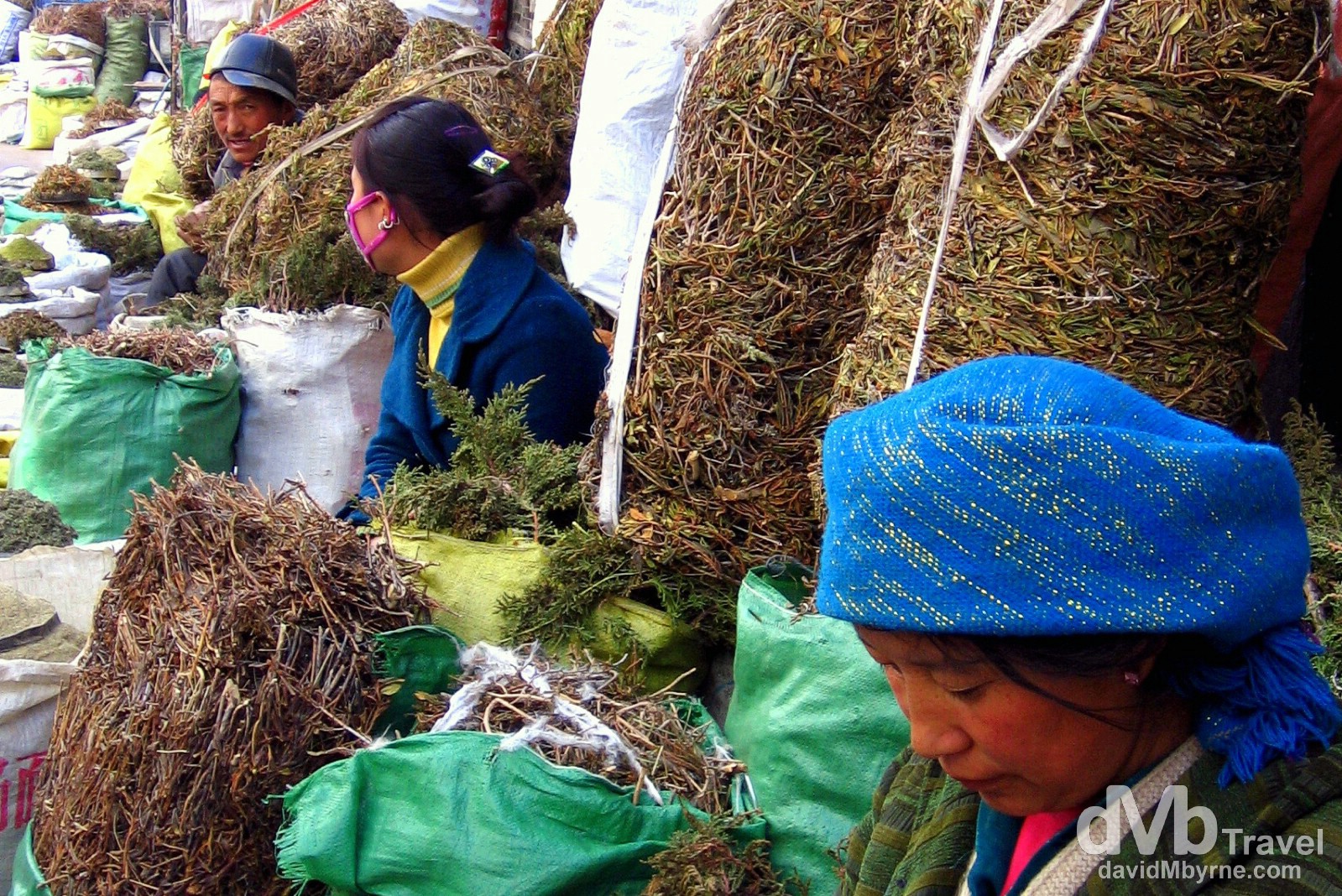
Working with (I assume) incense weed (the smell was amazing) in the lanes of the Barkhor district of Lhasa, Tibet. February 25th, 2008.
Onward Passage
We’ve also eaten Yak (no it doesn’t taste like chicken, more like beef, tough beef) and started the ball rolling on ‘securing onward passage to Nepal’ as Pat likes to call it, sounding all pioneering explorer-ish. If all goes to plan, we’ll be leaving here on Friday morning, sharing a 4×4 for the 5-day trip along the Friendship Highway from Lhasa to Kathmandu, Nepal, with a French couple, something that doesn’t now seem too bad an option considering we initially thought they were Israelis. We’ve been given a rough outline of the itinerary but all that really interests us about it is the part where it says when we get to Everest Base Camp (EBC). Again all going to plan, and assuming we don’t get AMS in the meantime, we’ll be staring up at Chomolungma (Everest in Tibetan) from 5,200 metres (17,700 ft) on Monday next, March 3rd. What a buzz that’s going to be. But first things first; we have more acclimatising to do, more yak to eat, more pilgrims to stare at, more beggars to dodge, (maybe) a few more Lhasa beers to consume and at least one palace and temple to visit.
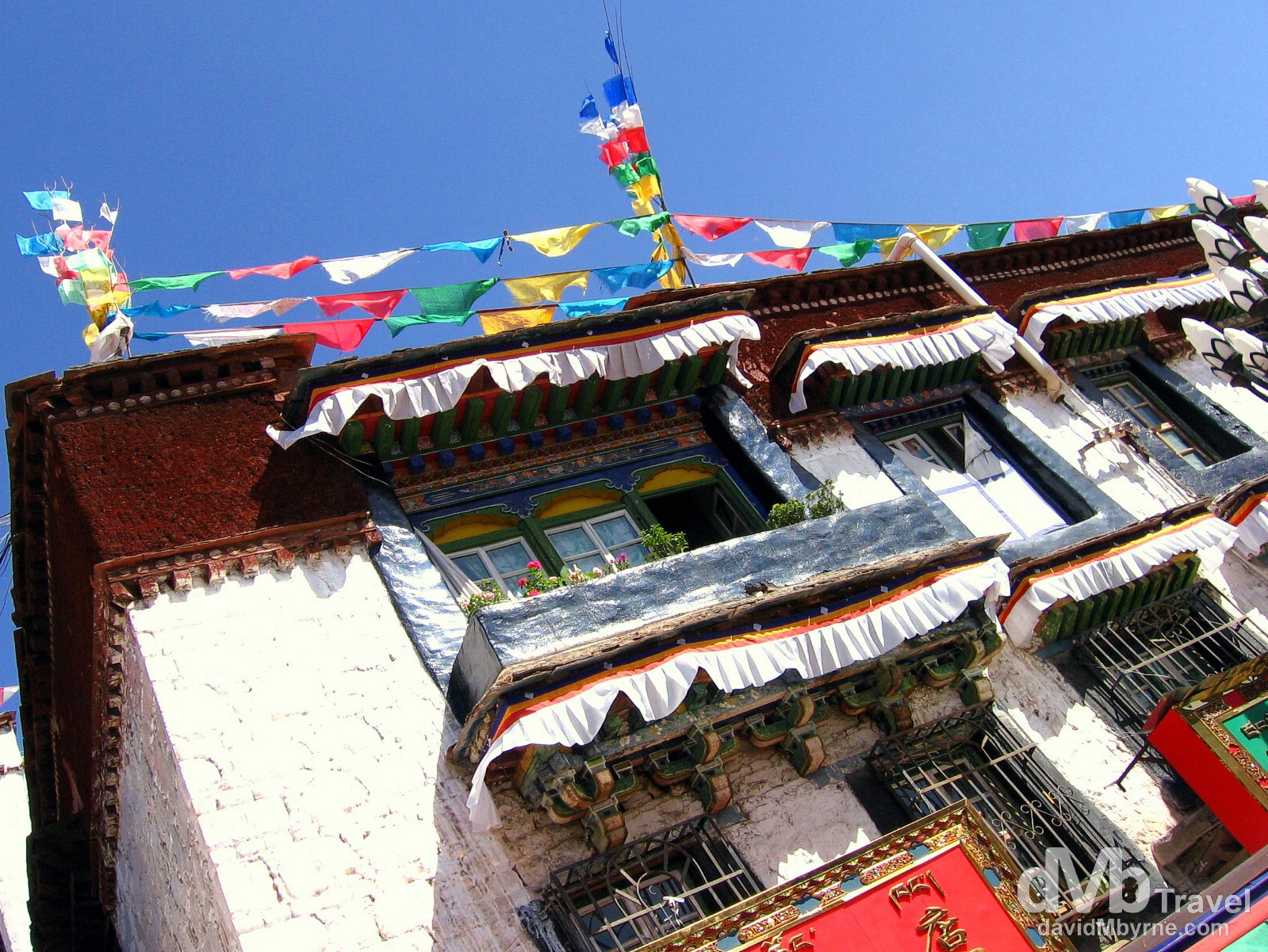
Typically colourful Tibetan architecture in the Barkhor area of the city. Prayer flags, as seen here, adorn the tops of all buildings in the city as well as most of the mountain tops surrounding it. Barkhor, Lhasa, Tibet. February 25th, 2008.
______________________________________________________________________
We’ve Been Good Boys || February 28th, 2008
______________________________________________________________________
Sadly our time in Lhasa has come to an end. We’re leaving here in the morning to begin our 5-day overland trip on the Friendship Highway that connects Lhasa to Kathmandu in Nepal. We’re hoping the last 4 days that we’ve spent here have sufficiently acclimatised us for what’s lies ahead. We’ve been good boys and have tried to follow the Avoiding Altitude Sickness information we have with us. We’ve rested, we’ve eaten well, we’ve started taking aspirin (which is seemingly good for the blood at high altitudes) and we’ve drank only in moderation, although whoops, last night we let our guard down a little. We’re probably making too much out of this whole altitude sickness thing but hey, neither of us wants to get sick on the upcoming trip and run the risk of ruining the trip for ourselves and our fellow travellers. So we’re doing what we can to help the cause. You see, I told you we have been good boys. Our parents would be proud.
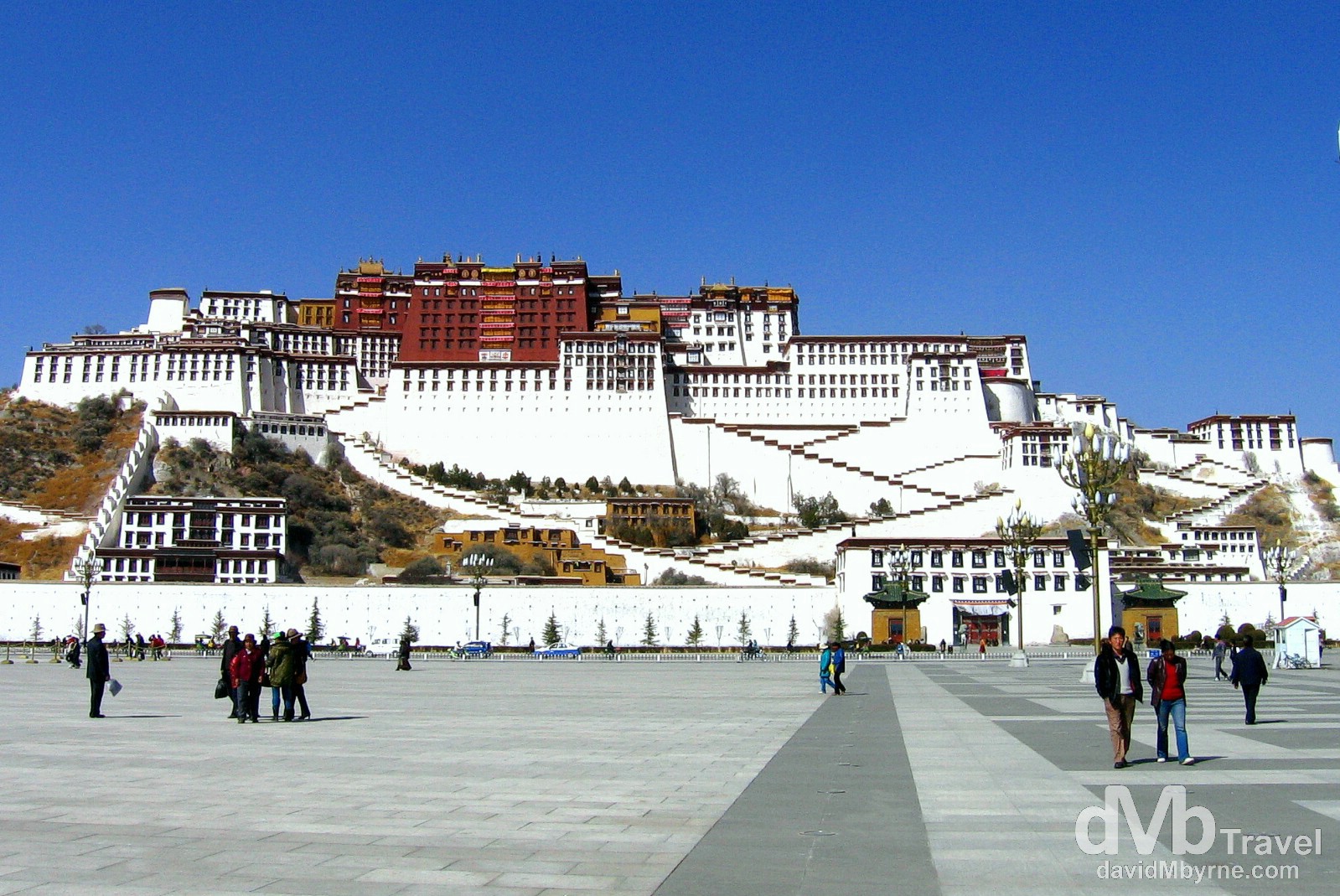
The Potala Palace as seen from People’s Park in Lhasa. The Potala Palace is the enduring landmark of Lhasa, the symbol of Tibet in the west and one of the most astonishing buildings in the world. The 110-metre-tall palace is perched 130 metres above the city atop Marpo Ri (Red Mountain) in the centre of the Lhasa Valley. Rising thirteen dramatic storeys and consisting of over a thousand rooms, the palace complex, comprising the White and Red Palaces with their ancillary buildings, took a workforce of at least seven thousand builders and fifteen hundred artists and craftsmen nearly fifty years to complete (1645-1693). The building measures 400 metres east-west and 350 metres north-south, with sloping stone walls averaging 3 metres thick – the walls are 5 meters (more than 16 ft) thick at the base where copper was poured to help proof the palace against earthquakes. The Potala was built for several purposes – it has served as administrative centre, seat of government, monastery, fortress and the home of all the Dalai Lamas up until the 14th Dalai Lama who fled to India following the failed anti-Chinese uprising of 1959. It’s widely regarded that today the palace is only a shadow of its former self; it has been forcibly converted into a museum by the Chinese but excited and awestruck pilgrims from all over ethnic Tibet still make their way here to give offerings at each of the palaces altars. We did visit the palace but unfortunately pictures were not allowed, a restriction that was strictly enforced by the palace monks. We saw a lot of Buddha’s in a lot of different chapels within the dark cavernous interior and also saw a few tombs of past Dalai Lamas, chief Lama (Buddhist priest) and once rulers of Tibet. Indeed, the three-storey, 3700 kg gold tomb of the Fifth Dalai Lama was mighty impressive and the highlight of the visit. But overall we were a tad disappointed by the visit – it was expensive (€10), the access to the rooftop wasn’t what we expected it to be and the restriction on taking pictures, even of the far-off mountains from the roof, was frustrating. Small rants I guess but again we are, of course, blaming the Chinese. Lhasa, Tibet. February 25th, 2008.
– UNESCO
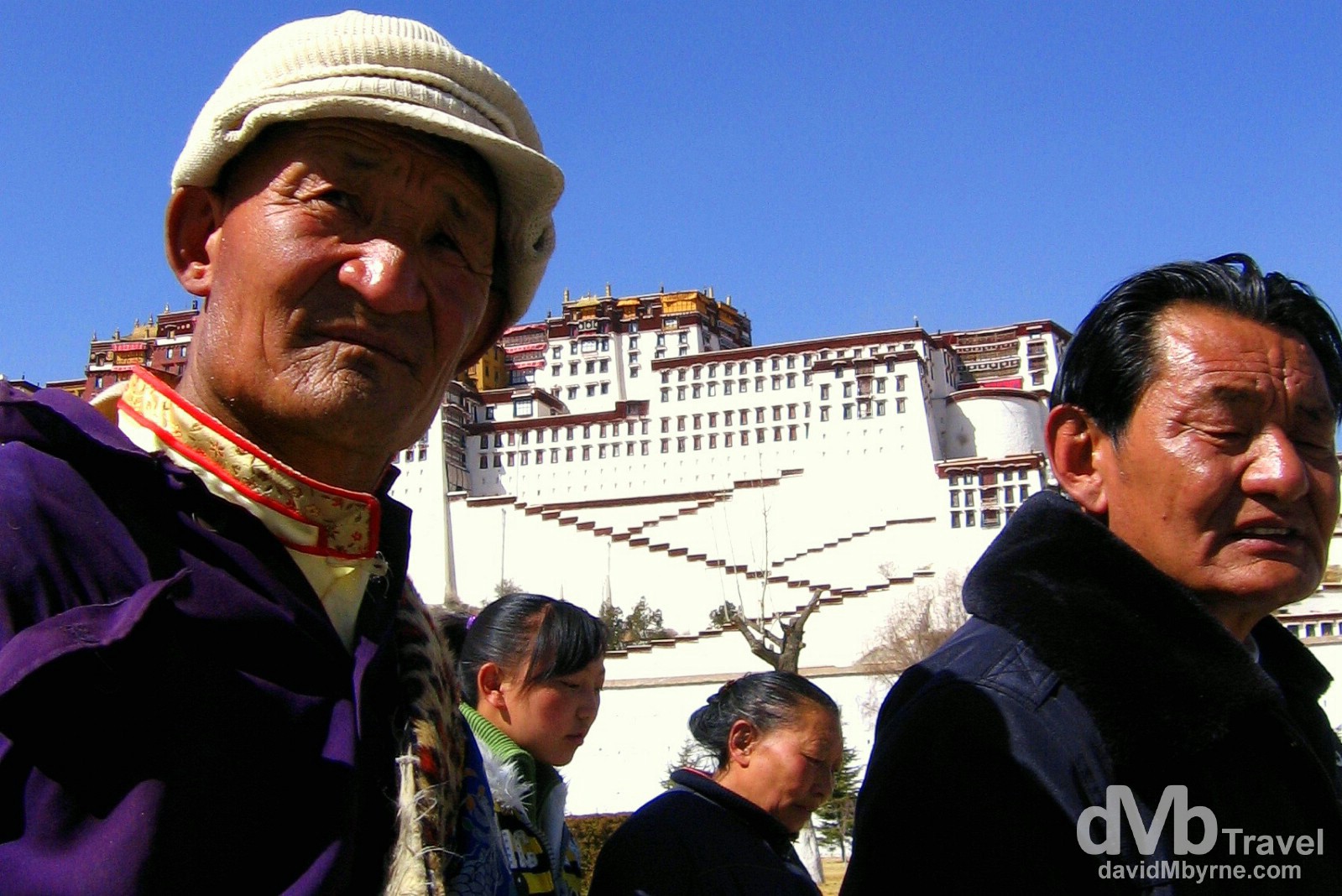
Fronting the Potala Palace in People’s Park, a mini Tiananmen Square situated in front of the imposing place. The square was seemingly designed to remind the Tibetans of their occupation; it houses a huge Chinese flag & an even bigger communist monument celebrating emm, ‘liberation’. People’s Park, Lhasa, Tibet. February 25th, 2008.
We’ve spent the last few days in the city generally taking it easy. We’ve stared at more pilgrims (pilgrims who have stared right back at us), we’ve dodged more beggars (beggars who didn’t want to dodge us) and we’ve visited both the Jokhang Temple and the Potala Place, using the roofs of both locations as viewing platforms from where we took in the full jaw-dropping splendour of the peaks surrounding the city.
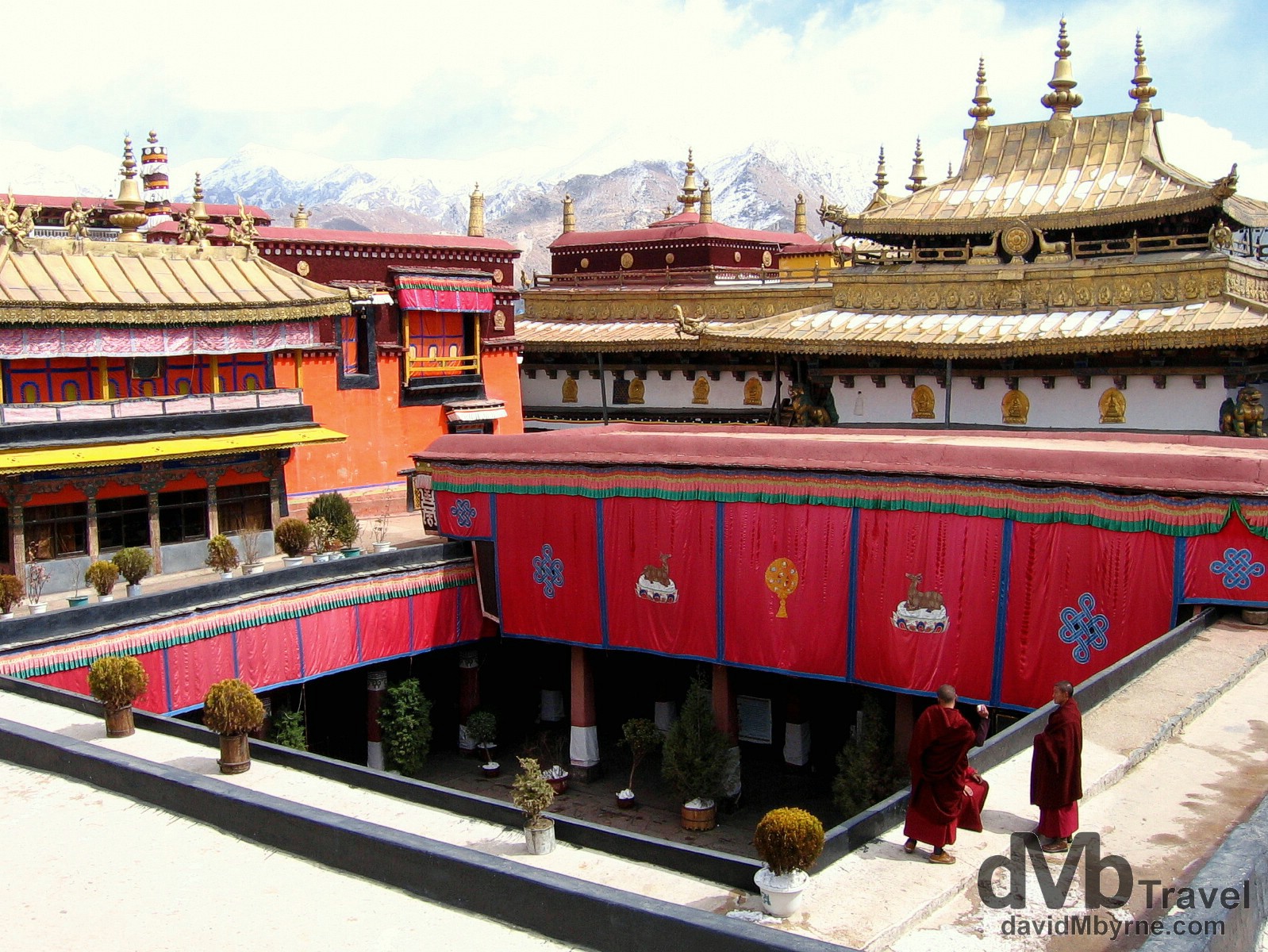
Young Buddhist Monks on the roof of the Jokhang Temple. Lhasa, Tibet. February 27th 2008.
– UNESCO
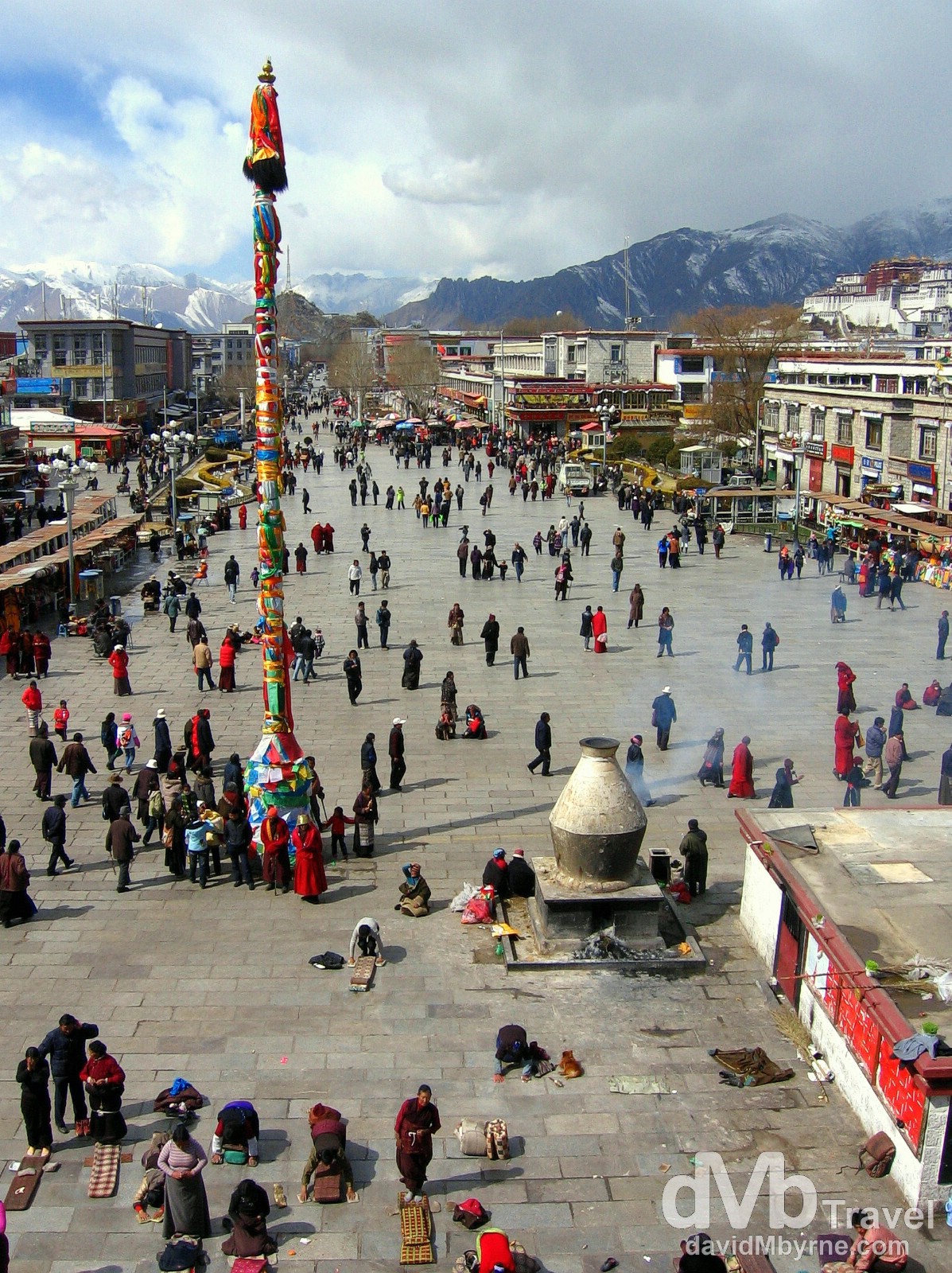
Barkhor Square as seen from the roof of the Jokhang Temple, Lhasa, Tibet. February 27th, 2008.
The views from atop both the Polata & Jokhang have certainly whetted our appetite for what’s in store on the Friendship Highway to Nepal, a road renowned for its scenic wonders, something you’d expect seen as the road traverses the Himalayas. For that trip we’ll be sharing a jeep with a French couple (Guigui & Oliver) & Ricky from Hiroshima. The 5 of us have spent the last few days negotiating an itinerary and a fair price with the owner of a Toyota Land Cruiser, one we’re sure we’ll all be comfortable in, bags and all. We’re happy with most things about the trip – the price (RMB3,500, about €350), the jeep, the driver and most importantly the itinerary which reads as follows:
Proposed Friendship Highway, Lhasa, Tibet, to Kathmandu, Nepal, Itinerary
· Day 1 – Friday February 29th Leave Lhasa (3,650m || 11,975ft) for Gyantse (3,950m || 13,000ft), stopping off to view Yamdrok-tso lake (4,488m || 14,800ft) from the Kamba-la pass (4,794m || 15,800ft). Overnight in Gyantse.
· Day 2 – Saturday March 1st Leave Gyantse for Shigatse (3,900m || 12,900ft). Overnight in Shigatse.
· Day 3 – Sunday March 2nd Leave Shigatse for Everest Base Camp (EBC) area passing the Gyatso-la pass (5,220m || 17,200ft, the highest pass of the trip. Overnight at a guesthouse near the Rongphu Monastery (9,980m || 16,400ft).
· Day 4 – Monday March 3rd Trek 7 kilometres to EBC (5,150m || 17,000ft). Mid-afternoon leave for Tingri (4,390m || 14,500ft). Overnight in Tingri.
· Day 5 – Tuesday March 4th Leave Tingri for Zhangmu (2,300mm || 7,590ft), on the Tibet-Nepal boarder. After clearing boarder formalities find onward transport to Kathmandu.
So there you have it. We’ll start that little adventure within an adventure in the morning. Because we’re looking after ourselves we’ll be avoiding Lhasa beer this evening hoping to have ourselves in tip-top shape for the 8:30 am departure. I’ll be updating our progress as we go but I’ll have my priorities – where we’re going we’ll be looking for heating and hot water before looking for internet access.
______________________________________________________________________
A Few Observations From || Lhasa, Tibet
· One of those moments
Our first look yesterday morning morning at the snow-capped peaks encompassing Lhasa from the roof of our aptly named Yak Hotel was one of those unforgettable travel moments. Pat proclaimed that the view “made the train trip worthwhile.” Here here.
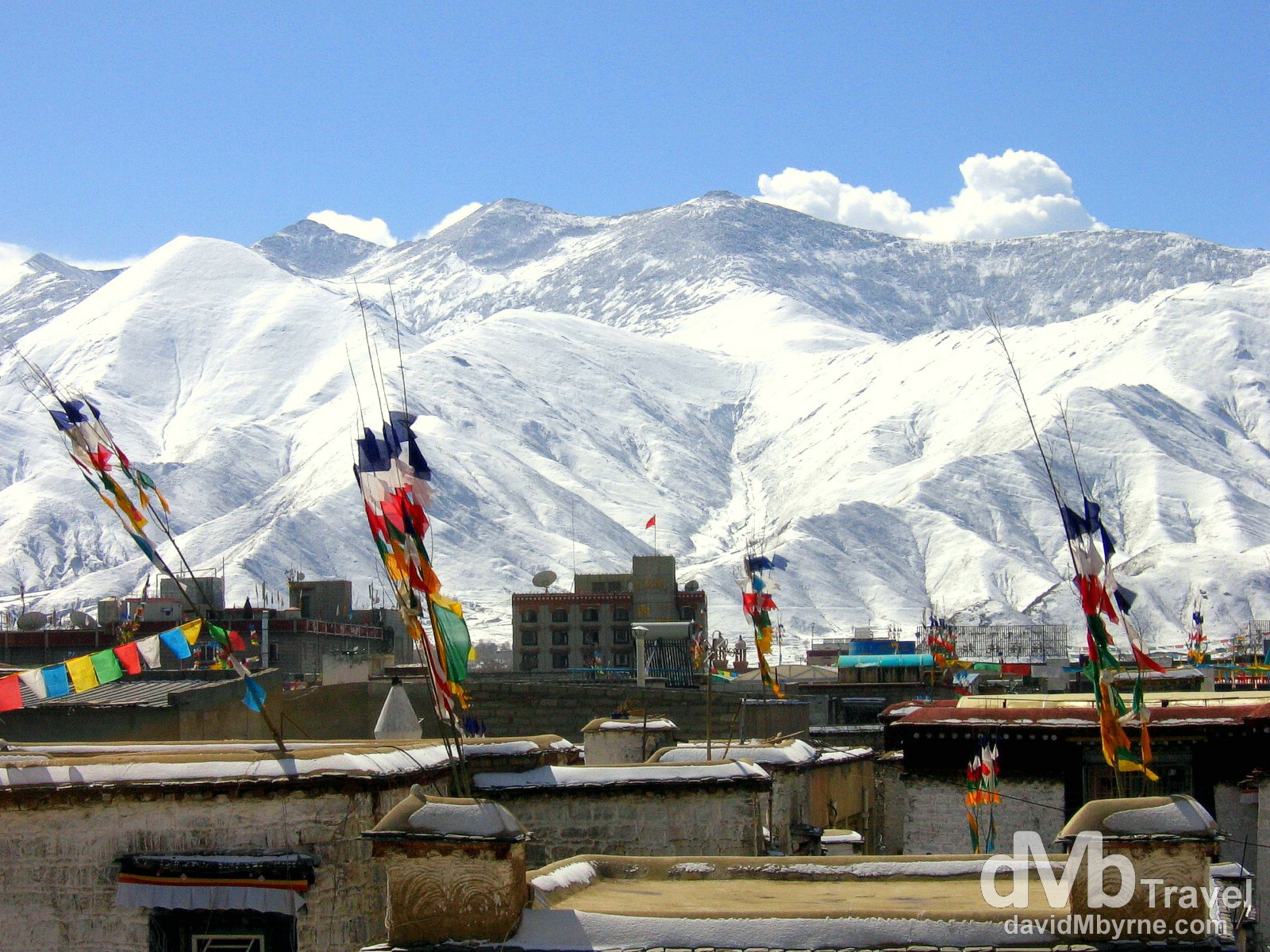
The view of the surrounding Himalaya Mountains from the rooftop of the Jokhang Temple in Lhasa, Tibet. February 27th, 2008.
· Offline
Internet access here sucks. There is no Wi-Fi anywhere and few internet cafes. Why? Remoteness may have something to do with it but we blame the Chinese of course (if you haven’t already noticed, we blame them for everything). They go to great lengths to monitor any communications emanating from Tibet and as a result internet access is restricted. Very restricted.
· Acclimatising?
We’re not sure if we can blame the Chinese on these, it’s more to do with the altitude and us acclimatising to same: sleeping erratically (both of us); shortness of breath (both of us), sunburn (fair-skinned me); slight headaches (Pat); and reduction of beer consumption (both of us), the latter being easily the most alarming side effect of acclimatisation thus far. Seemingly it’s not recommended to consume (large quantities of) alcohol while acclimatising & in its absence plenty of water & rest comes highly recommended. Which is convenient because we’ve found we generally have no desire to consume beer here in Lhasa. We’ve experimented (see next observation) but generally we’ve abstained. It’s weird we know and again we blame the Chinese.
· It’s (Not) Good For You
We had heard before getting here that drinking alcohol at high altitudes isn’t the wisest thing to do and doesn’t help much with acclimatising. Well, curiosity required Pat & I to determine whether that was scaremongering or no & thus through rigorous experimentation we have proven conclusively that yes indeed, alcohol should be avoided – even consuming small amounts results in a bad night’s sleep. Thus we have made the difficult but necessary decision to avoid beer until we get to the lower altitude of the Kathmandu valley (1,300 metres, 4,400 ft) in about 6 days from now, after which we’ll no doubt swiftly be making up for lost time.
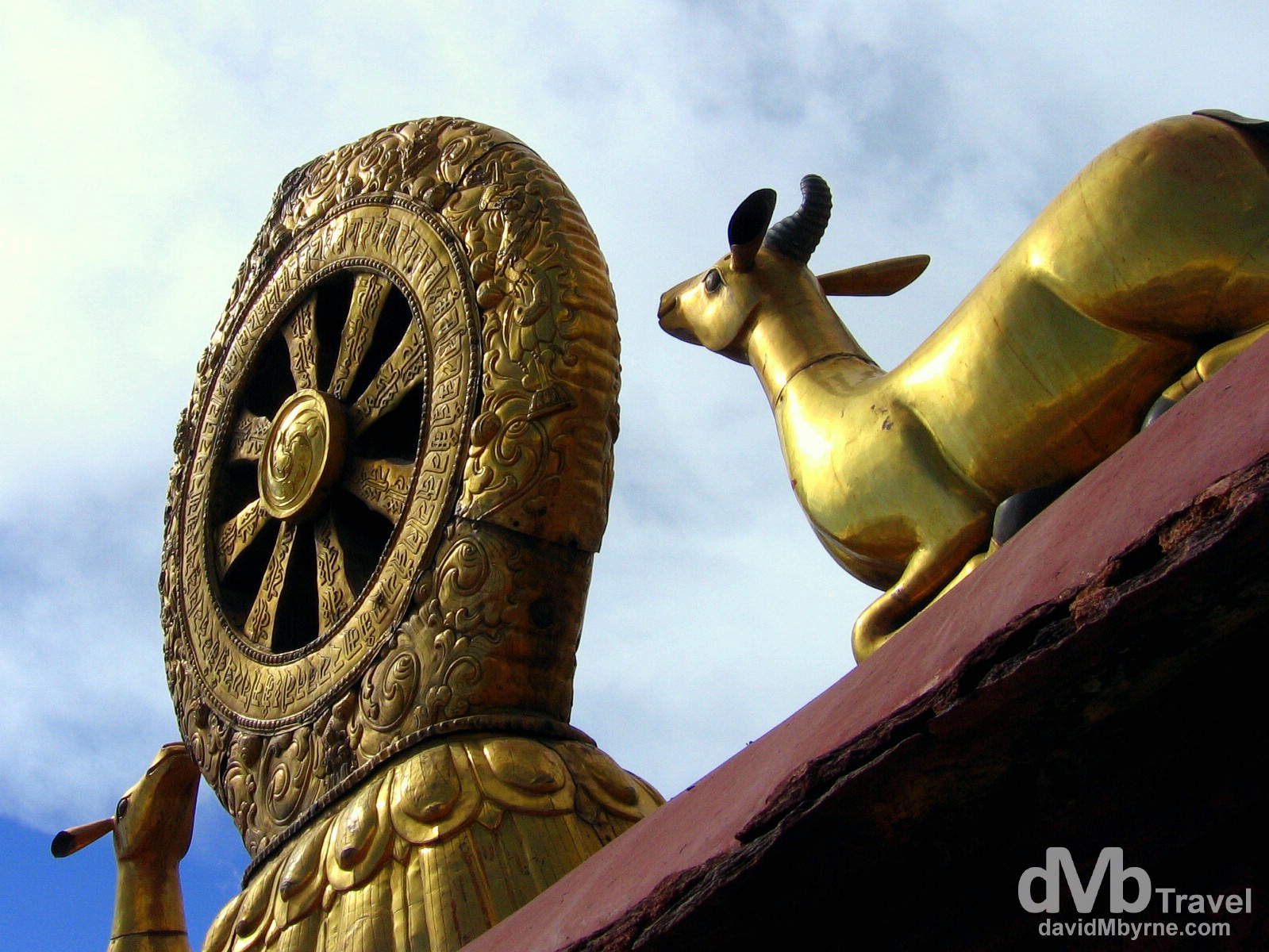
The roof of the Jokhang Temple in Lhasa, Tibet. February 27th, 2008.
· A happier lot
Tibetans generally seem to be happier with their lot than the Chinese. Yep, unlike the Chinese they actually smile here and they even acknowledge you when you walk into a restaurant or cafe. What a novelty that is having come from China.
· Western Stereotype
We’re definitely in the minority here. There are not too many other westerners on the streets of Lhasa this time of year and the ones that are here seem to confirm to the same visual stereotype – the Westerner-in-Lhasa wardrobe comprises of a pair of hiking boots, combat/cargo pants, a woolly jumper/sweater, a North Face jacket (Gore-tex of course) and a touque/bandanna to cover their (mostly) long, braided hair. We definitely standout as different (looking) kind of westerners, which is no surprise given our attire is more suited to a trip to the Costa del Sol than to the Himalayas.
· Lung Butter
The air pollution we’ve immersed ourselves in since we got this trip going back in Beijing some 2 weeks ago now seems to have caught up with us and these days we’re coughing a lot. We’re sounding like two old men who have spent half of their lives working in a coal mine and the other half smoking 40 a day. No sign yet however of the mucus that the locals here decorate the paths with when they are coughing up a lung (Pat has labelled it ‘lung butter’) but with some more weeks to come of breathing in what can only be described as less-than-ideal quality air it’s only a matter of time.
· What a waste
We’re probably never going to reach enlightenment for asking this (not that we’re searching for it of course) but after visiting the Jokhang Temple yesterday Pat & I were left wondering why anyone would want to be a monk. All they seem to do is sit around temples in a daze, chanting, banging drums and lighting incense. I guess we just don’t understand how one can devote ones whole life to a religion in such a way in the hopes of reaching enlightenment by, among other duties, the constant repetition of a physical act. To us it seems like such a waste.
· Junkies
Virtually any drug is available over the counter here in Lhasa and assuming you can communicate to the pharmacist what you want then you’ll get it for a fraction of what it would cost back home, no questions asked. Dr. Pat prescribed himself a few sleeping pills (I did mention we were sleeping erratically) and as I type he’s flicking through our India guidebook making a list of medicine we may need for the weeks we’ll spend dealing with its madness. While Pat’s getting help from the sleeping pills, about the only thing I’ve popped is a few aspirin to help prevent altitude sickness. They are budget busters with 20 of them costing a whopping 1 RMB (€0.10) here in Lhasa.
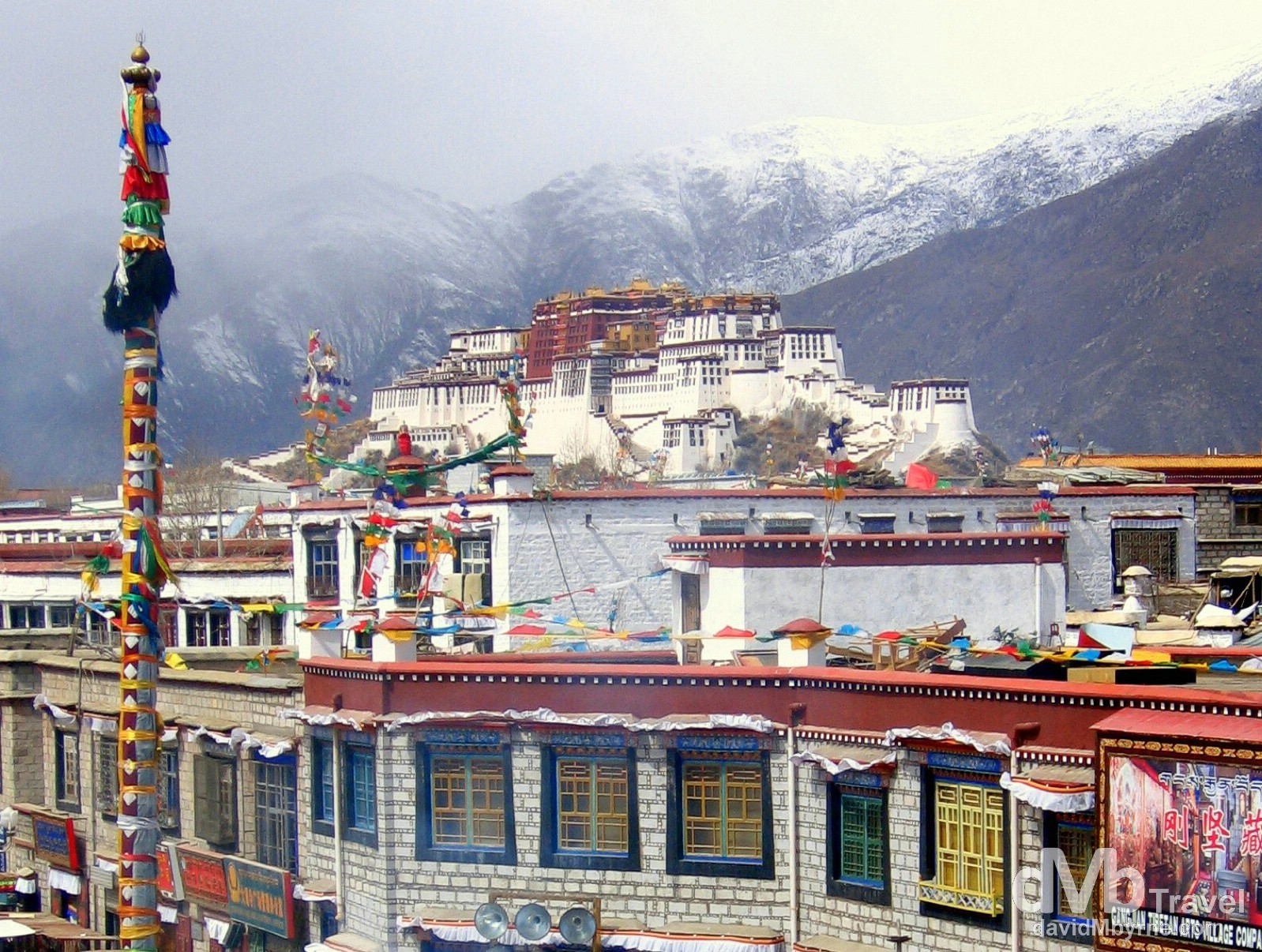
The Potala Palace as seen from the roof of the Jokhang Temple in Lhasa, Tibet. February 27th, 2008.
· Leap
This is a leap year. I hadn’t realised this until we were negotiating our Lhasa-Nepal itinerary with the jeep driver. It means we get an extra day of travel – when it should be March 1st it’s actually February 29th. Pat, showing his pessimistic side, stated that we best not have any ‘accidents’ on February 29th, stating that it would be an unfortunate ‘anniversary of woe.’
______________________________________________________________________

